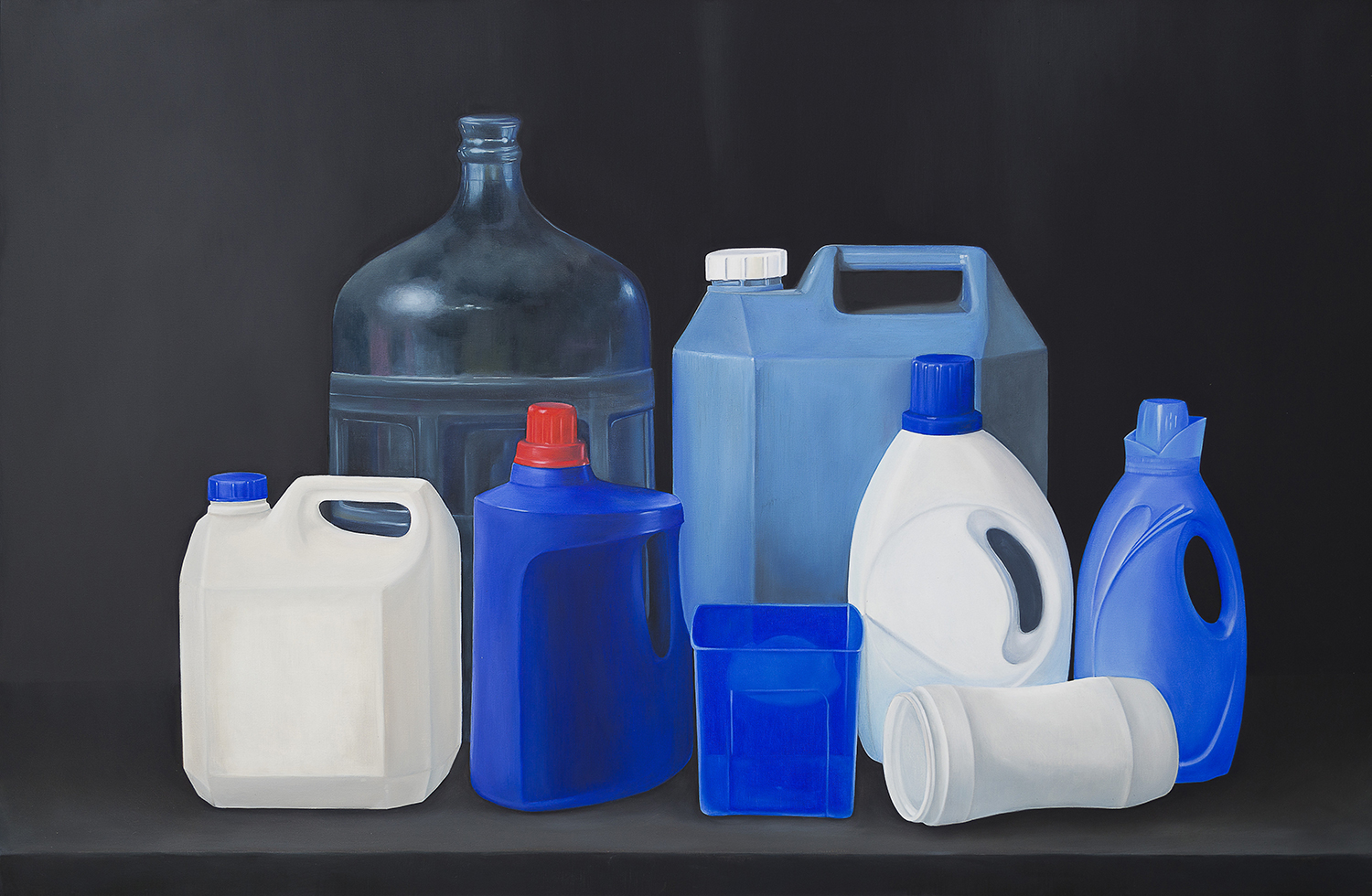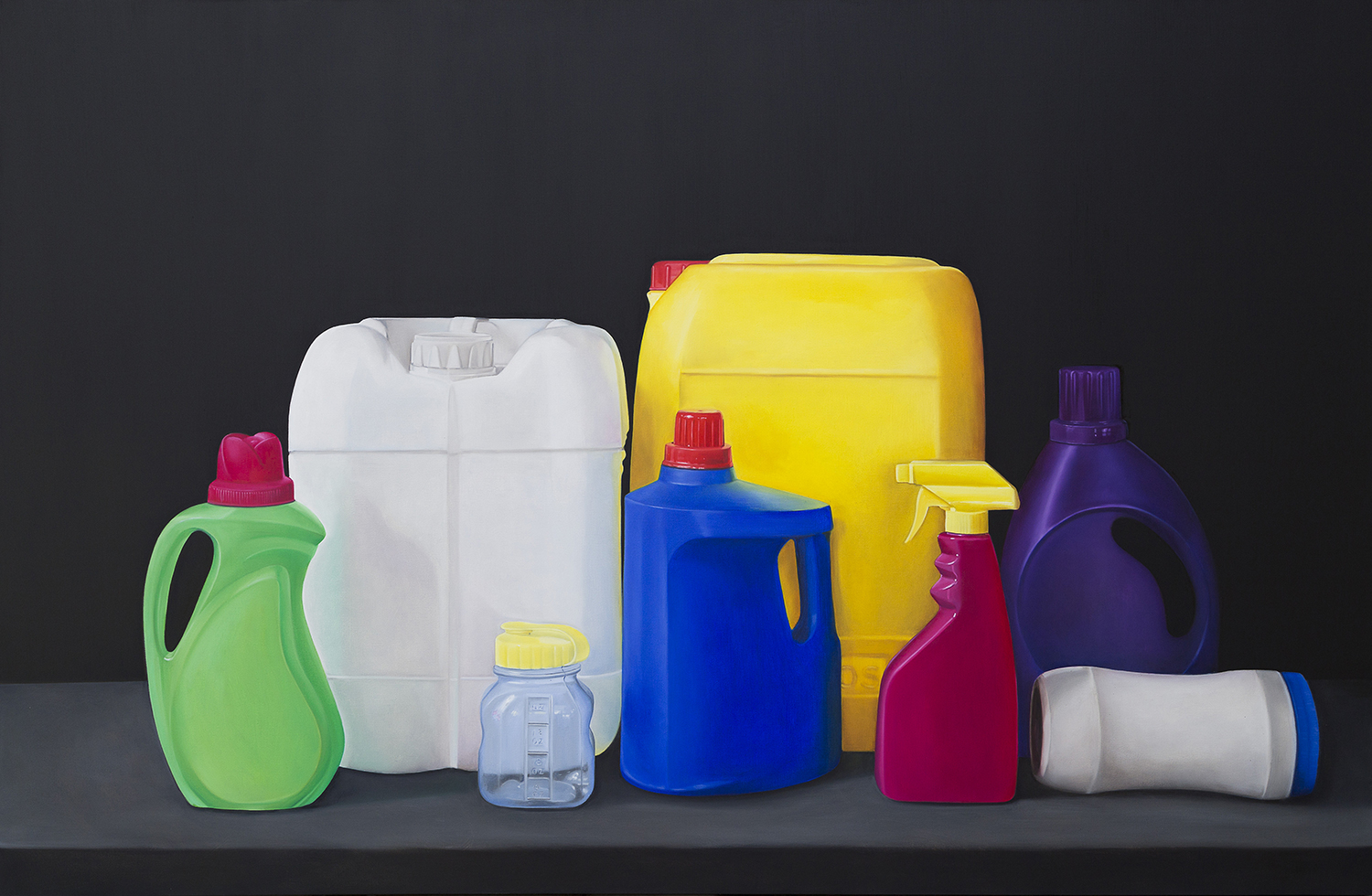Still life
Oil on canvas. 130x200 cms
By Ana Paola Peña Ospina
Independent Art Curator and Researcher
Still lives have a very long tradition in the history of art, the work presented by Ana Isabel Diez, is a diptych that dialogues and revisits this tradition, returning to a classical genre of painting to make it contemporary. Their still lives (Naturaleza Muerta) are two large oils that represent different plastic packages without labels, but clearly recognizable: the typical glass bottle of water, fabric softeners or some laundry detergent, a can, a small bottle, an atomizer, all frequently used objects in our daily life. The drums, as they are known, are made of a material that has become one of the great environmental nightmares in contemporary societies: plastic.
Paradoxically, these drums are also widely used by some communities to transport water, a vital liquid that, unfortunately, many populations still do not have in a drinkable way, or to transport chemicals that are used illegally in mining or drug production; or, even legally, to transport pesticides and herbicides that end up contaminating water sources and affecting populations - such as, for example, glyphosate -. The ambiguous nature of these plastic objects is what allows the artist to declare that "drums can be seen as a source of life and death". These drums are presented to us as a metaphorical object that allows us to express several contradictions that are based on cultural practices.
Still lives are also testimony to the customs of different eras. Those presented by Ana Isabel Diez, are a tragic and paradoxical portrait of contemporary society. The almost weightless drums realistically portrayed record a global and extremely serious problem, which is not easy to correct given its contradictory nature and the way in which the use of plastic has become a cultural practice almost intrinsic to everyday life, even, being aware of the environmental damage that its use represents. The aesthetization of the drums through their representation, invites us to contemplate them and reflect on their images: on one hand, if they will become the memory of a world in which the plastic once had a place or, on the other hand, if they will become a record of the environmental tragedy that we were not able to avoid.
By Ana Isabel Diez
Paradoxically, the main witnesses of our environmental woes are plastic drums.
On one hand, they become protagonists of the survival of a population when water (a scarce liquid in some regions during certain times of the year; in others, a regular situation) is transported in containers like this, that add color to the endless lines to which those affected are subjected. Then, as if painting the landscape, they fill the long, wasteful, dry and arid journey to the centers of consumption. They are the most viable, effective manner to carry water. Their life depends on them.
On the other hand, there are those drums, containers of death and destruction, where chemicals for illegal gold mining or drug business are transported; the pesticides that pollute water sources, which also threaten nearby communities. An almost eternal plastic presence, if we take into account its non – degradable nature.
"The plastic drum as a source of life and death."
In either case, it is nature in crisis, almost dead (a game of words with the expression used in Spanish to refer to STILL LIFE: dead nature). And this term leads me to construct these works.
“Still Life” or bodegones, a genre of painting that achieved great importance in the XVII Century, especially in Spain and the Netherlands. There, artists could position almost any object, which gave them freedom to create and experiment without being restricted to serious or religious themes. They also took the opportunity to fill them with symbolism. For this, they used elements such as skulls (vanitas), a symbol of temporality and mortality; hourglasses, books; musical and scientific instruments; different types of fruits and flowers; colors, etc.
From an ambiguous and disturbing element like plastic containers (drums), the problem of access to water is raised, as well as its care to ensure survival.
In referring to a classic genre of painting with modern elements, this becomes a situation that continues: the restricted access to water in some cultures and its care.
Moreover, the moralizing message of the ephemeral, mortality and the temporal, are recurrently present in the painting of STILL LIFE, reinforcing this concept: water as a limited resource and a determinant of life.



